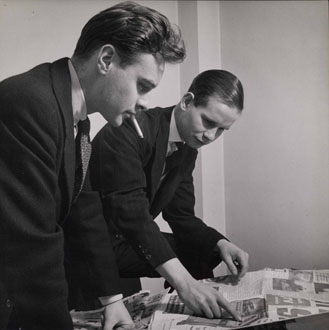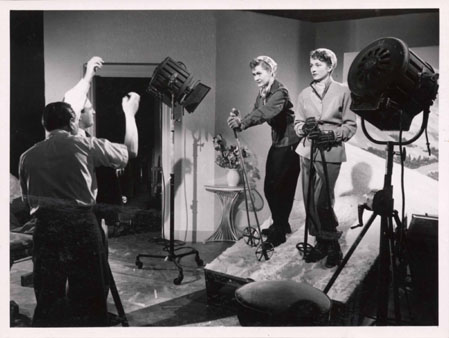The History of Advertising Trust (HAT Archive) has
been awarded a National Cataloguing Grant to catalogue its
collection of client account files created by the J. Walter Thompson (JWT)
advertising agency between the 1920s and 1970s. As the Project Archivist,
I commenced work at the end of March 2011 with the aim of launching an online
catalogue via HAT’s website in March 2013. Supported by HAT’s in-house archive
and technical team, including Alistair Moir, the new Collections Records
Officer, this pioneering project will also facilitate a broader cataloguing
programme that will offer the public more information, access and engagement
with HAT’s extensive archive collections.

• Two members of JWT staff at work - late 1950s
J. Walter Thompson, founded in the USA in 1878, was
the first advertising agency to take a ‘scientific’ approach to planning
campaigns with particular emphasis on the importance of in-depth market
research. JWT (London) was established as a full-service advertising
agency in 1926 and soon acquired a ‘reputation, based on its American
parentage, for hard-hitting, effective advertising, founded on solid research’
(Rayfield, ‘Fifty in Forty’, p.27). The JWT client account research
files, donated to HAT by the agency in the 1980s, are extremely rare and
significant within the UK advertising industry, as it appears that most of
these types of business files have not survived. Over 450 box files
document JWT’s management of its campaigns for nearly 200 clients and a typical
box file contains market research, product development, consumer panel
feedback, notes on competitive activity, sales figures, client correspondence,
meeting reports, advertising plans and strategies and themed reports relating
to many social and economic aspects of British life during the 20th
century. It is evident why JWT became known widely within the industry as
the ‘University of Advertising’ and the significance of this collection has
been compared by researchers to that of the Mass Observation Archive held by
the University of Sussex.
In addition complementary work is being undertaken
at HAT, in tandem with the NCG project, to catalogue and conserve JWT’s own
collection of over 700 guard books (1926-1990s), containing press advertising
proofs and TV/Radio scripts, as well as material relating to company history
e.g. press cuttings, office social events, seminars. JWT had long
and fruitful client relationships with some of the most iconic household brands
of the twentieth century and the guard books contain proofs for classic ads
such as the Horlicks ‘night starvation’ campaign (first use of continuity
strips adapted for advertising purposes), the ‘30-second breakfast’ for
Kelloggs and the pioneering use of film and stage star testimonials for leading
beauty brands.
JWT London has also deposited further historical
material at HAT including company minute books (1930s-1980s), billings
registers (1936-1943), advertising schedules for Radio Normandy and Luxembourg
(1935-1941), a photographic archive of JWT London personnel (1940s-1960s) and
other staff records. This archive is complemented by other collections at
HAT, including the papers of George Butler (JWT Art Director 1932-1962) and
John Treasure (JWT Chairman 1967-1974).

• Photoshoot for Lux Toilet Soap or Pond’s Cold
Cream advert
Advertising agency archives form the core of HAT’s
collections. Several major companies are represented from the Top Ten
agencies of their day and the juxtaposition of these collections facilitates
the study of each agency within a wider context. However, only JWT London
has its campaign research and strategy records still largely intact.
HAT’s JWT collection therefore attracts a broad spectrum of research enquiries
and is complementary to other archive collections e.g. JWT’s USA and other
international office records, held at the Hartman Centre for Advertising
History at Duke University, North Carolina. Leading academics in the
field of marketing history have already made extensive use of the JWT archives
at HAT and as a result of the NCG award, along with HAT’s online catalogue
development, many more researchers in the UK, as well as throughout the world,
will at last be able to access and study JWT London’s unique archives.
Jeremy Bullmore CBE, Head of JWT’s Creative Department (1964-1975) and Chairman
(1976-1987) and recent winner of the Mackintosh medal for outstanding services
to the advertising industry, says, ‘This is terrific news. And unlike
most news, it will go on being terrific for ever: that’s the real value of
an exceptional archive. For HAT to have been awarded this grant for this
particular project is cause for real celebration’.
The JWT client account files have already provided
me with some fascinating insights into the creative processes behind well-known
campaigns (e.g. the repositioning of Lux as a lifestyle brand in the 1920s or
the birth of ‘Mr Kipling’ in the 1960s!) and I look forward to bringing them to
a wider audience with the launch of HAT’s much anticipated online catalogue in
Spring 2013.
JWT helps get the work done ...
When a project, as vital to the advertising and marketing industry
as the cataloguing of JWT’s client research materials, receives recognition
from the National Archives, it is doubly encouraging to HAT to receive extra
funding from the agency itself, towards essential conservation materials for
use during the cataloguing work. Many thanks indeed to JWT’s Toby Hoare,
whose recognition of the project’s value stems from his knowledge of HAT’s rich
collections and resources.
Eve Read (JWT Project Archivist)
The History of Advertising Trust
eve@hatads.org.uk